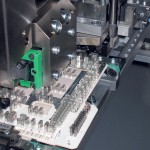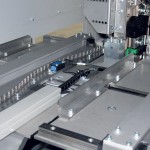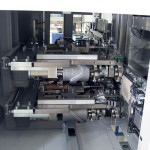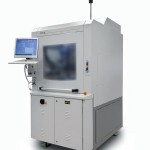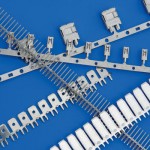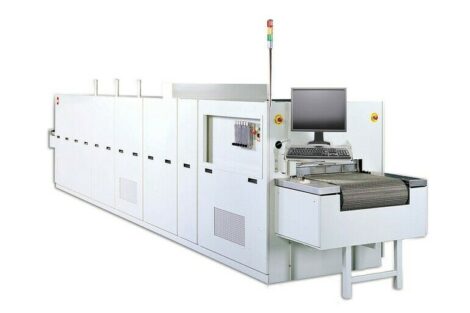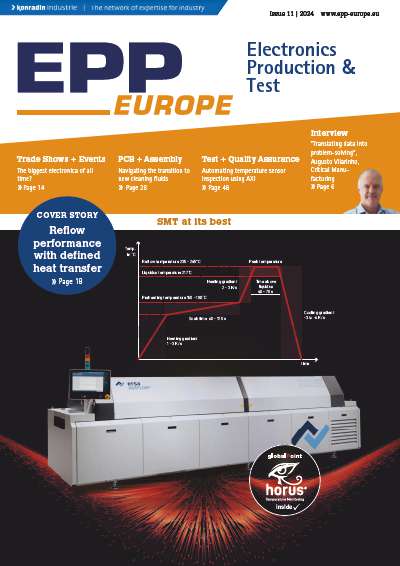Due to the growing demand for the press-fit technique of electrical contacts and other parts, IPTE has now developed and launched a new machine generation. The HSP (High-Speed Placer) 1000 is designed for different press-fit procedures at high throughput and is based on a proven and reliable process concept. The press-fit technology applied in modern electronics assemblies originates from space technology where extreme thermal conditions such as the very high temperature differences, as well as vibrations, etc. have to be withstood in order to fulfill the highest reliability and availability requirements placed on the airborne equipment. Press-in procedures for inserting component pins and contacts into PCBs are an essential part of problem solution for the electrical equipment.
The press-fit technique applied in modern electronics assemblies originates from space techno logy. Extreme thermal conditions within satellites and space shuttles such as the very high temperature differences, as well as vibrations, etc. adversely affected the solder joint quality especially besides others, and made it necessary to switch to other electronic connecting solutions in order to fulfill highest reliability and availability requirements placed on the circuitry. The problem has been resolved by press-in procedures for inserting component pins and contacts into the PCB. The application of the press-fit technique has, in the meantime, also become more popular in the field of sophisticated automotive electronics. It resolves not only the issue of the severe thermal conditions for electronics assemblies in vehicles, but also of the very high stress from vibrations and shocks. Furthermore, even the costly or otherwise delicate soldering process can be omitted depending on the component type processed, for example, in the case of components with flexible pins. But there are, of course, even more application advantages.
Due to the growing demand for the press-fit technique of electrical contacts, IPTE has developed a new machine generation. The HSP (High-Speed Placer) 1000 is designed for different press-fit procedures at high throughput, and is based on an already proven concept by now in use in multiple applications.
The process is as follows: The press-fit contacts are supplied to the machine cutting unit in the form of a metal ribbon from reels, and after the cutting step the insertion head picks up the single contact pieces. The PCB, located on an XY-cross table, is positioned precisely under the insertion head for the subsequent procedure in a parallel action which then provides the actual press-fit operation.
The modular HSP 1000 machine features high process performance and flexibility. By its curvilinear controlled insertion head up to eight contacts/second can be processed depending on the contact type. A machine can operate with two different insertion heads (for processing dissimilar press-fit contacts). Also, the high flexibility of the machine concept allows, for example, adding an option for the insertion of box-shaped contacts. And additionally the continuously variable insertion speed maintains a flexible adjustment to multiple insertion tasks.
Automated feeding of contact strips
As an option, the contact feeding mechanism of the HSP 1000 can be supplied as a “Zero Exchange System”. The feeder unit works this way: If one reel is empty, then the other full one will be used automatically without any further delay. The empty reel can then be exchanged from the staff later during normal machine operation. The results are a significantly higher degree of machine autonomy (unattended operation), and there is no break in the production flow since an immediate exchange of the reel is not necessary. Furthermore, the contact strips loaded in the equipment need not be laboriously brought in by hand but will be fed automatically into the insertion head. The HSP 1000 can process different contact strips with and without ribbon waste.
There is, of course, a choice of other helpful options beneficial for users. The insertion procedure can be provided being exactly controlled in the insertion force for an efficient and precise process monitoring. Also, programmable insertion angles for each single contact allow for non-orthogonal insertion positions.
The PCB support device can be supplied in the form of an anvil-type tool or as plate mechanism covering the entire surface according to the individual customer’s requirements. The high-dynamic XY-cross table for accurate and fast positioning the PCB under the machine head allows the flexible completion of insertion tasks with high performance.
The machine also comes with a lot more of advantageous constructive features. The insertion heads can be easily and quickly removed from the machine for trouble-free and comfortable upkeeping. The quick-exchange gripper system is especially practical for providing fast and effective service and maintenance tasks. The ribbon-cutting tool is designed in the way of a modular cartridge and is also externally pre-adjustable for the individual singulation jobs. The central lubrication system of the insertion head considerably minimizes the maintenance efforts.
Fulfilling future requirements as well
The compact machine features just a small footprint, not wasting space on the shop floor. This is very helpful for the successful and fast integration in existing production lines or electronics manufacturing environments. In addition to the working conveyor track, a feedback conveyor trail can also be integrated in the equipment. For the machine design and the further optimization of the press-fit technology, IPTE is cooperating with German specialist company Geissler Präzisionswerkzeuge GmbH.
This expert company delivers the appropriate press-fit contacts for different tasks. The special Geissler HighTemp press-fit contact pins feature low press-fit force, high retention force and consist of unique metal alloys which have a extremely high temperature stability to up to 150 °C. Furthermore, they can also withstand high vibrational stress and other loads. A collection of these special press-fit contacts is already in use in various projects within the global automotive industry.
Because of this innovative technology supplied by IPTE and its partner, a major manufacturer of electronic products containing press-fit type PCB assemblies has decided to invest in a considerable IPTE manufacturing line equipped with a couple of HSP 1000 machines. One important argument of consideration for this capex decision was the especially high modularity and flexibility of the HSP 1000 which would enable customers to efficiently manufacture future products as well in this growing and demanding market.
IPTE has advanced the concept of the press-fit technology in further engineering due to individual customer requirements regarding the press-fit procedure of complete electrotechnical modules such as connector assembly boards or similar component units. Based on the IPTE odd-form placement machine series, also a unique flex-press machine was developed which can process these connector assembly boards precisely controlled in the press-fit force up to 4,500 N. Stick feeders, tray loaders, sorting conveyors or special feeder units designed according to the individual customer requirements can efficiently supply the components and parts to the machine.
In a nutshell: With this highly flexible and versatile solution for many different press-fit applications, IPTE’s automation experts demonstrate again their ability to design efficient machines with innovative concepts. The versatile HSP 1000 is such outstanding example projected for various press-fit procedures at high throughput which enables users to successfully provide this task in many different manufacturing environments with high performance, precision and reliability. (gbw)
electronica, booth A1.632
EPP Europe 416
zusammenfassung
Aufgrund der steigenden Nachfrage für Kontakt-Einpresstechnik etwa in der Automobilbranche hat der Spezialist für Automatisierungstechnik eine neue Maschinengeneration aufgelegt, die für unterschiedliche Einpressvorgänge bei hohem Durchsatz ausgelegt ist. Das Prinzip: Die Kontakte werden als Band von der Rolle einer Schneideinheit zugeführt, geschnitten und dann vom Setzkopf abgeholt. Parallel dazu wird mit einem XY-Kreuztisch die Leiterplatte für den Einpressvorgang positioniert und anschließend der Kontakt vom Setzkopf eingepresst.
En raison de la demande croissante de pressage de contacts, par exemple dans le secteur automobile, le spécialiste des techniques d’automatisation a mis au point une nouvelle génération de machines conçues pour divers processus de pressage à rendement élevé. Principe : les contacts sont amenés à une unité de coupe sous la forme de bandes provenant de la bobine, coupés, puis saisis par la tête de pose. En parallèle, le circuit imprimé est positionné pour le processus de pressage à l’aide d’une table à mouvements croisés XY, puis le contact est pressé par la tête de pose.
A seguito della richiesta sempre maggiore di stampaggio di contatti nel settore automobilistico, lo specialista della tecnologia dell’automazione ha avviato la produzione di una nuova generazione di macchine concepite per diversi tipi di stampaggio ad alta produttività Il principio: i contatti vengono alimentati come nastro dal rullo di un unità di taglio, tagliati e prelevati dalla testa di inserzione. Allo stesso tempo il circuito stampato viene posizionato da un tavolo a croce XY per la stampa e quindi per il contatto viene stampato dalla testa di applicazione.
Share:




